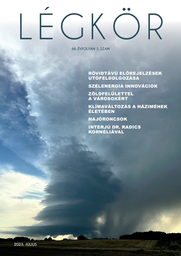LÉGKÖR - Quarterly Newsletter
Vol. 68, No. 3 * Pages 118–180 * July 2023
 |
|
 download [pdf: 37207 KB]
download [pdf: 37207 KB]
Operational statistical post-processing of short-range global radiation and low-level wind forecasts
Szépszó Gabriella, Baran Ágnes, Baran Sándor, Jávorné Radnóczi Katalin, Kornyik Miklós, Tajti Dávid
DOI:10.56474/legkor.2023.3.1 (pp. 118–125)
Szépszó Gabriella, Baran Ágnes, Baran Sándor, Jávorné Radnóczi Katalin, Kornyik Miklós, Tajti Dávid
DOI:10.56474/legkor.2023.3.1 (pp. 118–125)
Wind energy innovations in the world
Péliné Németh Csilla, Bíróné Kircsi Andrea, Dobi Ildikó
DOI:10.56474/legkor.2023.3.2 (pp. 126–130)
Péliné Németh Csilla, Bíróné Kircsi Andrea, Dobi Ildikó
DOI:10.56474/legkor.2023.3.2 (pp. 126–130)
Improving urban living environment with green structures
V. Horn Valéria
DOI:10.56474/legkor.2023.3.3 (pp. 131–137)
V. Horn Valéria
DOI:10.56474/legkor.2023.3.3 (pp. 131–137)
The effects of atmospheric variables and changing climate on honey bees (Apis mellifera)
Vincze Csilla, Leelőssy Ádám, Mészáros Róbert
DOI:10.56474/legkor.2023.3.4 (pp. 138–147)
Vincze Csilla, Leelőssy Ádám, Mészáros Róbert
DOI:10.56474/legkor.2023.3.4 (pp. 138–147)
LÉGKÖR - Quarterly Newsletter
A folyóirat nyomtatott változata megrendelhető a legkor@met.hu címen.
Kapcsolat: legkor@met.hu
SZERKESZTŐBIZOTTSÁG
SZERZŐI ÚTMUTATÓ
Kapcsolat: legkor@met.hu
SZERKESZTŐBIZOTTSÁG
SZERZŐI ÚTMUTATÓ









